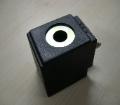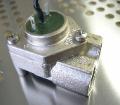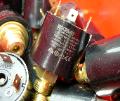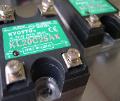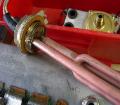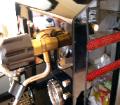The Espresso Machine Restoration site
A non-commercial site for those interested in espresso equipment repair and restoration.

Ideal pressure is
around 9 bar
9 bar is 135psi
Very noisy - There may be some air in the water line or the mains water supply is off.
Check the mains supply.
Not pumping - Assuming that the motor is OK, the pump may have some debris or
object blocking it. Try and turn by hand and/or descale. Also make the sure that if it
has a check valve, it is not blocked. If it turns and still not pumping then you need to
replace.
Pressure adjustment - Turn the acorn screw clockwise to increase and anticlockwise
to decrease.
Can it be rebuilt? Yes only at the factory though. Do not attempt to do it yourself!
Capacitors
measured in uf
Replace with the
same uf capacitor
Motor not turning (1) - Ensure the electrical connections are good. If so check that
the capacitor is OK by checking the ohms. Set multimeter on the highest ohms setting
then connect the leads to the 2 terminals on the capacitor. The display value should
rapidly decrease then increase after it reaches zero. If you reverse the leads (swap
polarity) and the same readout occurs then the capacitor is ok.
Motor not turning (2) - It has been known that a screw or similar object can block the
motor from turning. Also check that the fan casing at the back is aligned - if the cooling
fins are blocked that will stop the motor from turning.
Motor starts slowly - Replace the start capacitor.
Test coil.
0.7kohms - 0.8kohms
Lack of flow from group head (1) - If water supplu and flowmeters are ok, the 3 way
valve is blocked. Clean with a detergent such as Puly Caff.
Lack of flow from group head (2) - Valve coil is dead. Check ohm reading of the coil.
0.7-0.8k ohms is a good coil.
Water dripping from group head or into drain - The plunger (piston) gasket and
spring may be worn. Replace the plunger and spring.
Filling of boiler has a problem - Slow flow would indicate scale build-up inside valve -
descale. No flow may indicate a severe blockage or dead coil. Contantly filling (coil not
energised) may indicate plunger is worn.
Test field sensor.
1.8kohms -2.4kohms
Lack of flow to group head - Check the inlet hole is not blocked. It is very small.
Blocked flowmeter - Take apart, clean and descale.
Water leaking from flowmeter - Check pipe fittings and tighten if necessary. If
leaking from the main body replace the o-ring.
Computer says no flow - Check mains water supply and group 3 way valve for
operation. If ok check the field sensor on the flowmeter. Ohms reading between the
"+" and "0" terminal should be 2.2k. Check also that the magnets are ok.
Deadband of 0.5 bar
max.
Check continuity
between Common
and NC
Safety Valve blowing at 1.8bar - Adjust the p-stat downwards. If it continues check
the membrane (on a Sirai) and replace if it is stiff. If after adjusting the p-stat
downwards the deadband is too large replace the p-stat (CEME or MATER) or the
membrane on a Sirai.
No power to heating elements (1) - Check the high temp safety fuse and push the red
button back in. This is an indication that your p-stat is on it's way out and needs
replacement.
No power to heating elements (2) - Check the relay or contactor switch for operation.
Check the switch to
see if it closes
during operation.
Clean contacts.
No power to heating elements - Check that the switch is working. Check that the coil
is OK and that the switch is closing when energised. If the contacts are clean and ok
then check the power leads for the elements and then the safety pop fuse.
Make certain the contactor can handle the power of the element.
Make certain the contactor is of the correct voltage. i.e. A1 and A2 input is the
correct 110V or 220V.
Add a heatsink.
Mount in a cool
place.
No power to heating elements - If the voltage accross the load terminal is OK then
check the switching voltage. If it is OK the SSR is not good. It may have overheated.
remember that an SSR is useless without a good heatsink and the rating is dramatically
reduced without a heatsink.
Use an appropriate heatsink and heat transfer compound.
Make sure the input is what you need, i.e. AC or DC,
Make the sure the rating is suitable.
Ensure correct
voltage
Check wiring and
safety fuses.
Water not heating - Check that the elements are receiving a current. If not it could be
the pressure switch or the thermostat. Check the wiring.
Water heating very slowly - Check that the elements are the correct wattage for that
size boiler. Check for limescale build up on the elements. If no scale then replace the
elements.
Replace
gasket/washer
frequently.
Use a silicone
lubricant.
Valve does not close properly and steam leaks from the tip - You must replace the
gaskets inside the valve, usually the end stopper gasket. It could also be the spring
inside that is not returning the valve back into position. It could also be that inside the
valve there is no lubricant - you should use a silicone lubricant.
Valve will not open - May be stuck with scale or dirt.
No steam - Valve tip is blocked with milk. Clean the holes with a paper-clip. If boiler is
hot and tip is free of milk then the blockage is further up. It may be scale or dirt.
will say yes, but please ask first!
Email me here.


